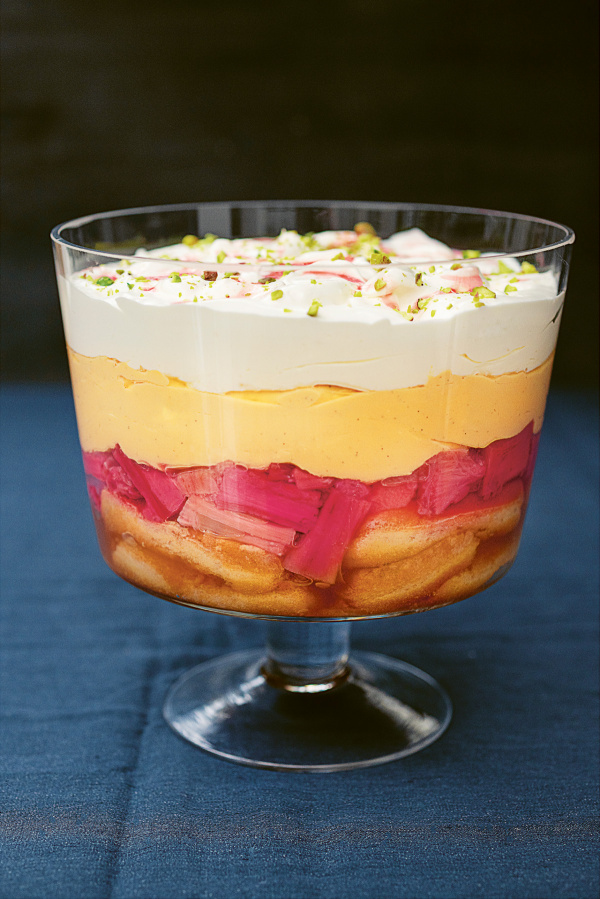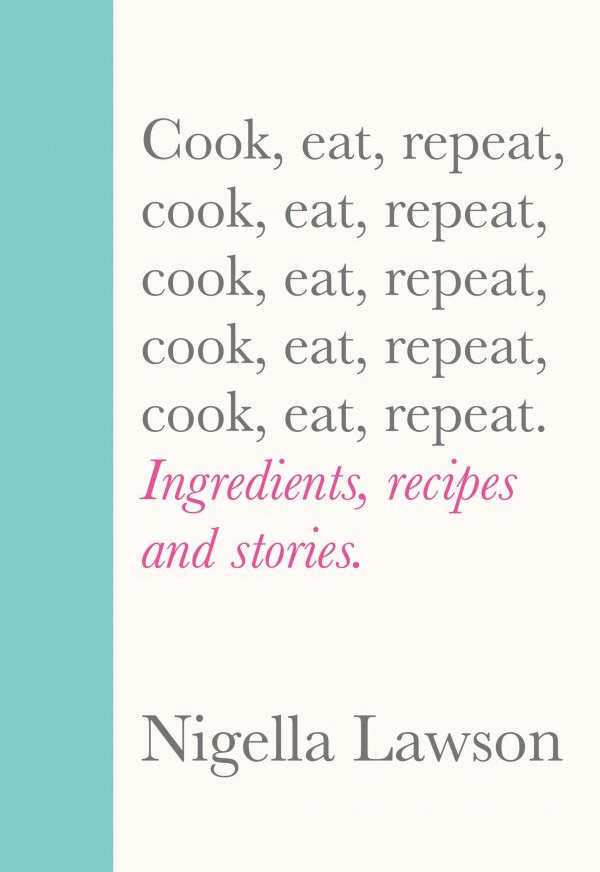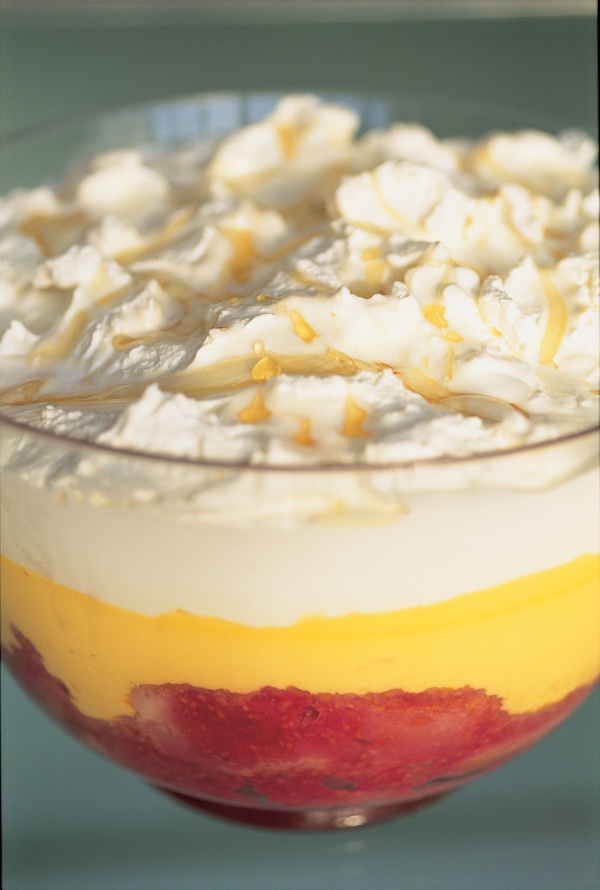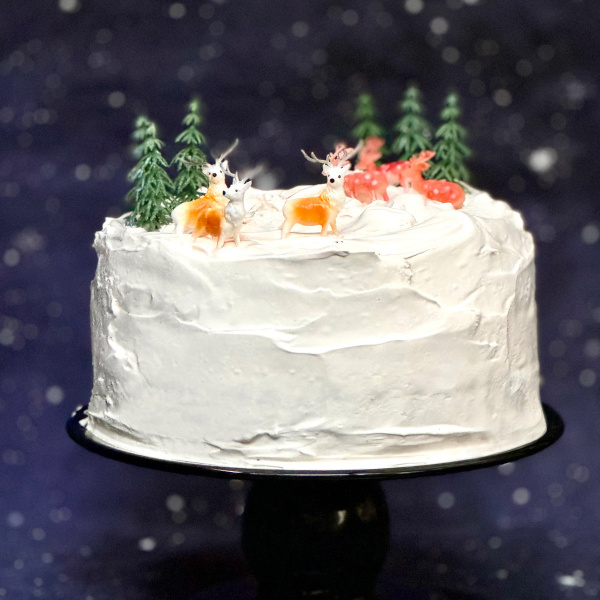Rhubarb and Custard Trifle
by Nigella. Featured in COOK EAT REPEATIntroduction
I have published many recipes for trifle and made even more, and this is the one I return to most, even though it’s the first time I’ve actually written it down. This simple, joyous pile-up of sponge, rhubarb, custard and cream is my favourite of favourites, and it’s time I shared it with you.
Don’t get too nervous about the length of the recipe: just remember that a trifle has a few component parts; even if none of those parts is difficult, the whole is necessarily process-heavy. I know that making the custard can be a worry for many, so let me assure you that this is easy-peasy: the inclusion of double cream and cornflour mean that it thickens quickly and smoothly.
For me, it’s the hallowed pairing of vanilla-speckled custard and sherbetty-sharp rhubarb that makes this the dreamiest of trifles. And what a beauty, too: maybe it’s because it reminds me of my favourite boiled sweets when I was a child, but I can’t look at the bright-striped combination of yolk-rich yellow and absurdly hot pink without smiling. And I must tell you, too, that the red vermouth that soaks the sponges (along with the rhubarb juice) is a total game-changer.
One last thing: while I’ve given precise quantities below, bear in mind that these are based on the proportions of my trifle bowl, which is 20cm / 7½ inches diameter and 13cm / 5 inches deep. If you’re using a wider bowl, you will need to boost quantities or the layers will be too shallow.
I have published many recipes for trifle and made even more, and this is the one I return to most, even though it’s the first time I’ve actually written it down. This simple, joyous pile-up of sponge, rhubarb, custard and cream is my favourite of favourites, and it’s time I shared it with you.
Don’t get too nervous about the length of the recipe: just remember that a trifle has a few component parts; even if none of those parts is difficult, the whole is necessarily process-heavy. I know that making the custard can be a worry for many, so let me assure you that this is easy-peasy: the inclusion of double cream and cornflour mean that it thickens quickly and smoothly.
For me, it’s the hallowed pairing of vanilla-speckled custard and sherbetty-sharp rhubarb that makes this the dreamiest of trifles. And what a beauty, too: maybe it’s because it reminds me of my favourite boiled sweets when I was a child, but I can’t look at the bright-striped combination of yolk-rich yellow and absurdly hot pink without smiling. And I must tell you, too, that the red vermouth that soaks the sponges (along with the rhubarb juice) is a total game-changer.
One last thing: while I’ve given precise quantities below, bear in mind that these are based on the proportions of my trifle bowl, which is 20cm / 7½ inches diameter and 13cm / 5 inches deep. If you’re using a wider bowl, you will need to boost quantities or the layers will be too shallow.

Share or save this
Ingredients
Serves: 8-10
FOR THE CUSTARD
- 600 millilitres double cream
- 1 vanilla pod or 2½ teaspoons vanilla paste (or extract)
- 6 large egg yolks at room temperature
- 2 x 15ml tablespoons plus 2 teaspoons caster sugar
- 1 x 15ml tablespoon plus 1 teaspoon cornflour
FOR THE BASE
- 1 kilogram pink forced rhubarb (trimmed weight)
- 250 grams caster sugar
- 175 millilitres red vermouth
- 12 trifle sponges
FOR THE TOPPING
- 300 millilitres double cream
- Approx. 3 x 15ml tablespoons chopped or nibbed pistachios
FOR THE CUSTARD
- 2½ cups heavy cream
- 1 vanilla bean or 2½ teaspoons vanilla paste (or extract)
- 6 large egg yolks at room temperature
- 2 tablespoons plus 2 teaspoons granulated sugar
- 1 tablespoon plus 1 teaspoon cornstarch
FOR THE BASE
- 2¼ pounds pink hothouse rhubarb (trimmed weight)
- 1¼ cups granulated sugar
- ¾ cup red vermouth
- 18 - 22 savoiardi cookies
FOR THE TOPPING
- 1¼ cups heavy cream
- Approx. 3 tablespoons chopped or nibbed pistachios
Method
- Get on with the custard first. Pour the 600ml / 2½ cups of double cream into a heavy-based saucepan (I use one of 22cm / 9 inches diameter), split the vanilla pod lengthways (if using), and use a pointy coffee spoon or the tip of a knife to scrape the damp black seeds into the cream. Drop in the pod, as well. Bring to a bubble but don’t let it boil, then take it off the heat straightaway and cover with a lid to let it infuse for 20 minutes. Remove the vanilla pod, run it under the water from the tap to get any cream off, then leave it to dry and use it to scent sugar. If you’re not using a vanilla pod, just warm the cream and add vanilla paste or extract once your custard is made.
- Gently whisk the egg yolks, caster sugar and cornflour in a batter jug or whatever suits you. Keep whisking while you gradually pour in the warm cream and make sure it is all smoothly amalgamated. Wash out the saucepan and dry it – just use water, you don’t need soap. Pour the custard mixture from your jug into the pan (using a bendy spatula to scrape out every last eggy bit from the bottom) and cook over medium heat for a minute, stirring with a wooden spoon (preferably one with a pointy bit to help scrape up bits from the bottom), and then on low heat, still stirring mostly with a wooden spoon, but transferring to a little whisk every now and again, too, until thick enough that it coats the back of a wooden spoon and, when you run your finger through it, it doesn’t run into the bare stripe. I reckon this takes about 5 minutes altogether. Mind you, I do like to live dangerously. Go more slowly if you wish, and, at whatever speed you’re going, take the pan off the heat regularly, and whisk the custard, to make sure it doesn’t get too hot, especially around the edges of the base of the pan.
- As soon as it’s cooked, take it off the heat and scrape it into your batter jug (adding vanilla paste or extract if you haven’t gone the vanilla pod route), then cover with a damp scrunched-up piece of baking parchment to stop it forming a skin. (Even writing ‘skin’ in conjunction with custard makes me feel quite ill.) Once the custard has cooled down, put it into the fridge to chill.
- Meanwhile, get on with the rhubarb. Heat the oven to 200℃/180℃ Fan/400°F. Cut the trimmed rhubarb into about 5cm / 2 inch lengths if the ribs are slender; if chunky, cut into about 2½ cm / 1 inch pieces. Put into an ovenproof dish in which they can (mostly) sit in a single layer — I use a large baking tin measuring 37 x 34cm / 15 x 14 inches, though you could get away with one a bit smaller — and sprinkle over the 250g / 1 cup of caster sugar. Mix together well with your hands, leaving the rhubarb in a single layer, as much as possible, then cover the tin or dish with extra-wide foil, sealing the edges, and cook in the oven for approx. 30 minutes until the rhubarb is tender but still holding its shape.
- Once the rhubarb is just cooked, let it stand out of the oven with the foil removed for 20 minutes. You might be disappointed with the colour the moment it comes out of the oven, by the way, but after a few minutes it will begin to glow a bright candy pink. Gently transfer with a slotted spoon or spatula (or both) to another dish for now. You should have about 300ml / 1¼ cups of liquid in the tin, although if you wait about 5 minutes, you will see more juice collecting under the rhubarb in its dish; add that to the juice in the tin.
- Set aside 125ml / ½ cup of the rhubarb juices for now and measure out another 175ml / ¾ cup of the rhubarb juice (I should say that by the end of the forced rhubarb season it seems to make less liquid; if you don’t have enough, I suggest you make up the amount with orange juice), then add to it the red vermouth. Taste one teaspoon just for the joy of it, although once you do so, it will be hard not to drink the rest.
- Now make the rhubarb syrup for the top of the trifle. Pour the reserved 125ml / ½ cup of rhubarb juice into a small heavy-based saucepan, bring to the boil and bubble away to reduce to a viscous syrup. I reckon if I start off with 125ml / ½ cup, it takes about 4 minutes to bubble away (in a small, 14cm / 6 inches diameter saucepan) to 60ml / ¼ cup. If you start off with more, still aim to reduce it by half; any further than that and it will turn to rhubarb toffee. And if that does happen, just stir in a little hot water from the kettle to get it to a thick pouring consistency.
- Arrange your trifle sponges at the bottom of your trifle bowl, brushing off as much as you can of the sugar coating as you go. Squodge them in as you like, tearing them up as needed to fill any gaps; I tend to go for a layer about 5–6cm / 2 inches deep. Pour your very delicious rhubarb-vermouth liquid over, as evenly as you can, and let the dry little trifle sponges drink it up thirstily, as any sensible person would.
- Top the drenched trifle sponges with the rhubarb and pour over any juices that have collected in the dish. Once the custard is properly cold, carefully scrape it into the trifle dish on top of the rhubarb, smoothing it to the sides, trying not to smear the glass. The pink of the rhubarb underneath the yellow of the custard is a sight that makes me smile; a fond reminder of the boiled rhubarb & custard sweets of my childhood. Cover the dish with food wrap and put into the fridge overnight.
- Take the trifle out of the fridge a good 2 hours before you intend to eat it. Shortly before serving, whip the double cream — I like mine quite softly whipped — and spoon gently over the set custard. Use the back of your spoon to create a few whorls and whirls. Drip as much as you want of your reduced rhubarb syrup pinkly over the top and scatter over chopped or nibbed pistachios.
- Get on with the custard first. Pour the 600ml / 2½ cups of heavy cream into a heavy-based saucepan (I use one of 22cm / 9 inches diameter), split the vanilla bean lengthways (if using), and use a pointy coffee spoon or the tip of a knife to scrape the damp black seeds into the cream. Drop in the pod, as well. Bring to a bubble but don’t let it boil, then take it off the heat straightaway and cover with a lid to let it infuse for 20 minutes. Remove the vanilla bean, run it under the water from the tap to get any cream off, then leave it to dry and use it to scent sugar. If you’re not using a vanilla bean, just warm the cream and add vanilla paste or extract once your custard is made.
- Gently whisk the egg yolks, granulated sugar and cornstarch in a batter jug or whatever suits you. Keep whisking while you gradually pour in the warm cream and make sure it is all smoothly amalgamated. Wash out the saucepan and dry it – just use water, you don’t need soap. Pour the custard mixture from your jug into the pan (using a bendy spatula to scrape out every last eggy bit from the bottom) and cook over medium heat for a minute, stirring with a wooden spoon (preferably one with a pointy bit to help scrape up bits from the bottom), and then on low heat, still stirring mostly with a wooden spoon, but transferring to a little whisk every now and again, too, until thick enough that it coats the back of a wooden spoon and, when you run your finger through it, it doesn’t run into the bare stripe. I reckon this takes about 5 minutes altogether. Mind you, I do like to live dangerously. Go more slowly if you wish, and, at whatever speed you’re going, take the pan off the heat regularly, and whisk the custard, to make sure it doesn’t get too hot, especially around the edges of the base of the pan.
- As soon as it’s cooked, take it off the heat and scrape it into your batter jug (adding vanilla paste or extract if you haven’t gone the vanilla bean route), then cover with a damp scrunched-up piece of baking parchment to stop it forming a skin. (Even writing ‘skin’ in conjunction with custard makes me feel quite ill.) Once the custard has cooled down, put it into the fridge to chill.
- Meanwhile, get on with the rhubarb. Heat the oven to 200℃/180℃ Fan/400°F. Cut the trimmed rhubarb into about 5cm / 2 inch lengths if the ribs are slender; if chunky, cut into about 2½ cm / 1 inch pieces. Put into an ovenproof dish in which they can (mostly) sit in a single layer — I use a large baking tin measuring 37 x 34cm / 15 x 14 inches, though you could get away with one a bit smaller — and sprinkle over the 250g / 1 cup of granulated sugar. Mix together well with your hands, leaving the rhubarb in a single layer, as much as possible, then cover the tin or dish with extra-wide foil, sealing the edges, and cook in the oven for approx. 30 minutes until the rhubarb is tender but still holding its shape.
- Once the rhubarb is just cooked, let it stand out of the oven with the foil removed for 20 minutes. You might be disappointed with the colour the moment it comes out of the oven, by the way, but after a few minutes it will begin to glow a bright candy pink. Gently transfer with a slotted spoon or spatula (or both) to another dish for now. You should have about 300ml / 1¼ cups of liquid in the tin, although if you wait about 5 minutes, you will see more juice collecting under the rhubarb in its dish; add that to the juice in the tin.
- Set aside 125ml / ½ cup of the rhubarb juices for now and measure out another 175ml / ¾ cup of the rhubarb juice (I should say that by the end of the hothouse rhubarb season it seems to make less liquid; if you don’t have enough, I suggest you make up the amount with orange juice), then add to it the red vermouth. Taste one teaspoon just for the joy of it, although once you do so, it will be hard not to drink the rest.
- Now make the rhubarb syrup for the top of the trifle. Pour the reserved 125ml / ½ cup of rhubarb juice into a small heavy-based saucepan, bring to the boil and bubble away to reduce to a viscous syrup. I reckon if I start off with 125ml / ½ cup, it takes about 4 minutes to bubble away (in a small, 14cm / 6 inches diameter saucepan) to 60ml / ¼ cup. If you start off with more, still aim to reduce it by half; any further than that and it will turn to rhubarb toffee. And if that does happen, just stir in a little hot water from the kettle to get it to a thick pouring consistency.
- Arrange your savoiardi cookies at the bottom of your trifle bowl, brushing off as much as you can of the sugar coating as you go. Squodge them in as you like, tearing them up as needed to fill any gaps; I tend to go for a layer about 5–6cm / 2 inches deep. Pour your very delicious rhubarb-vermouth liquid over, as evenly as you can, and let the dry little savoiardi cookies drink it up thirstily, as any sensible person would.
- Top the drenched savoiardi cookies with the rhubarb and pour over any juices that have collected in the dish. Once the custard is properly cold, carefully scrape it into the trifle dish on top of the rhubarb, smoothing it to the sides, trying not to smear the glass. The pink of the rhubarb underneath the yellow of the custard is a sight that makes me smile; a fond reminder of the boiled rhubarb & custard sweets of my childhood. Cover the dish with food wrap and put into the fridge overnight.
- Take the trifle out of the fridge a good 2 hours before you intend to eat it. Shortly before serving, whip the heavy cream — I like mine quite softly whipped — and spoon gently over the set custard. Use the back of your spoon to create a few whorls and whirls. Drip as much as you want of your reduced rhubarb syrup pinkly over the top and scatter over chopped or nibbed pistachios.
Additional Information
MAKE AHEAD:
Prepare trifle (without cream layer) up to 1 day ahead, cover and refrigerate. Remove from fridge 1-2 hours before serving, then top with whipped cream.
STORE:
Refrigerate leftovers, covered, for up to 2 days.
MAKE AHEAD:
Prepare trifle (without cream layer) up to 1 day ahead, cover and refrigerate. Remove from fridge 1-2 hours before serving, then top with whipped cream.
STORE:
Refrigerate leftovers, covered, for up to 2 days.






Tell us what you think
Thank you {% member.data['first-name'] %}.
Explore more recipesYour comment has been submitted.
What 2 Others have said
-
Posted by joshv41680 on 30th April 2022
-
Posted by Domestaroo on 13th April 2022
Show more commentsThis was spectacular! The red vermouth was an unexpected addition, but it really complimented the rhubarb. The beautiful, candy pink rhubarb syrup for the topping took the whole thing over the top. Truly luscious!!
This was served at Sunday Lunch with Nigella at Melbourne Food and Wine Festival…it was divine! Creamy, of course, but the rhubarb made it fresh and sharp.